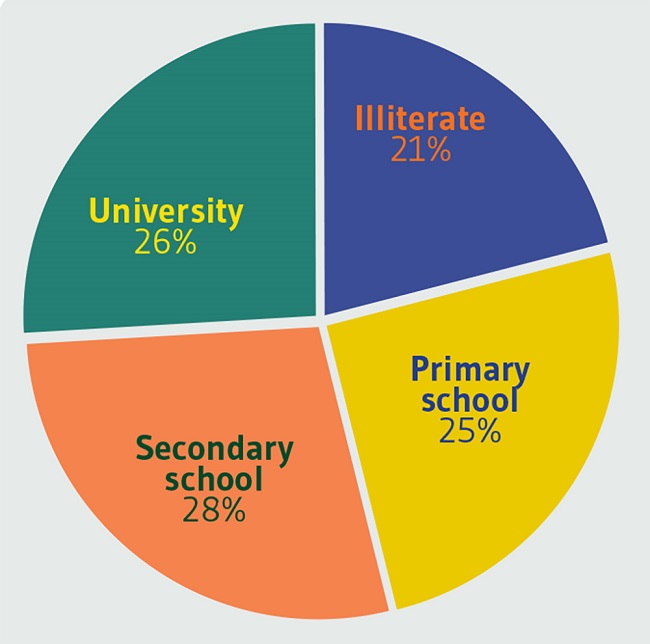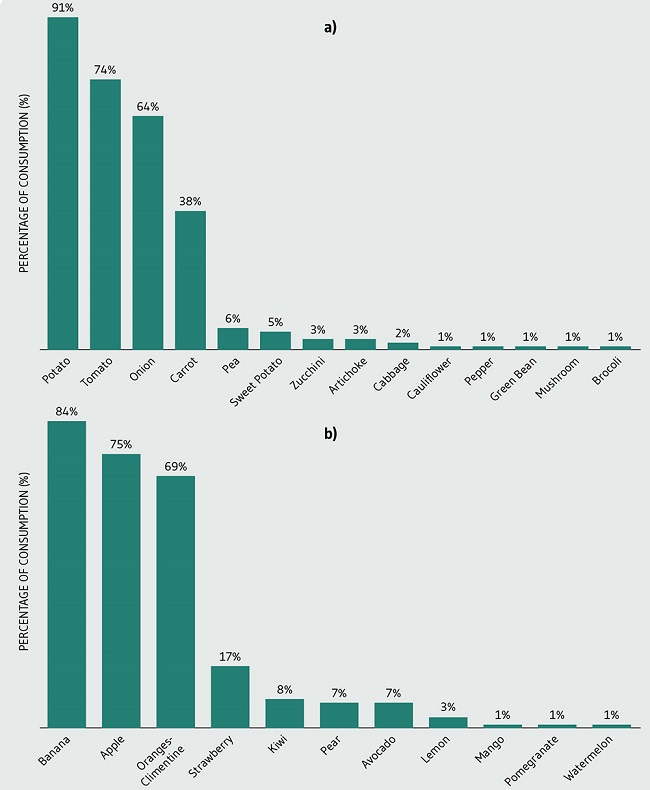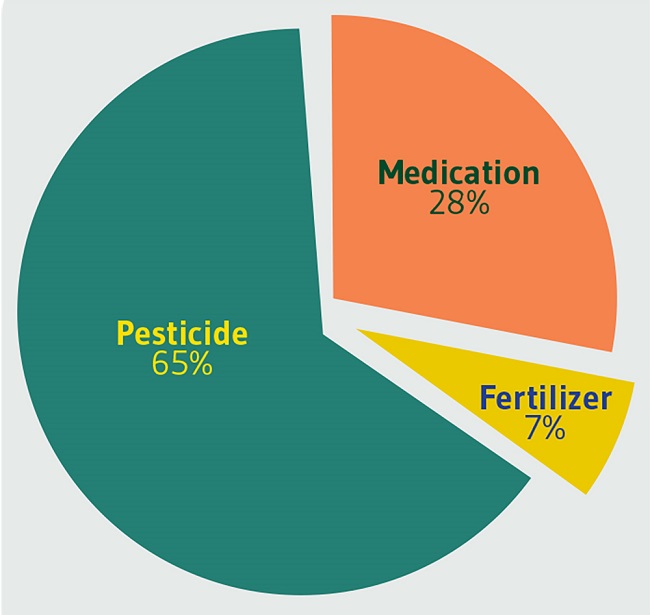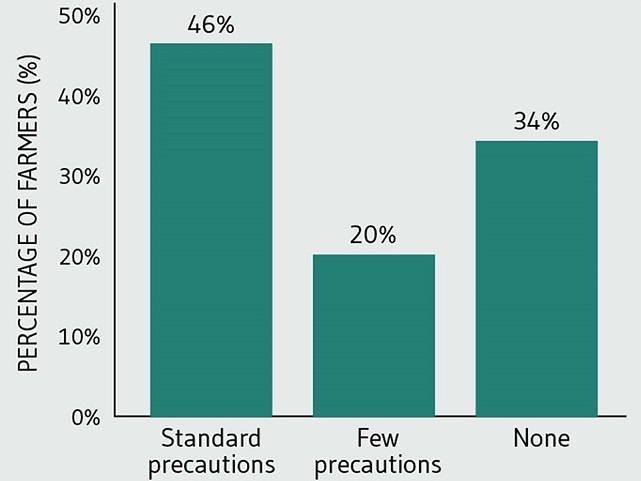Key Messages
From the 100% people surveyed, 91%, 74%, 64% and 38%, consume potatoes, onions, tomatoes, and carrots, respectively. In terms of fruit, 84%, 75%, 69%, consume bananas, apples, and oranges, respectively and few of them consume strawberries, kiwi, pear and avocado.
About 53% of the consumers surveyed know the meaning of organic fruits and vegetables. When asked if they know pesticides, 6% know about pesticides as fertilizers, 35% know about them as medicines while only 59% know about them as poisons.
For the 50 farmers surveyed, 90% of them had no training in pesticides and their applications. About 34% do not use any means of precaution when applying pesticides. Also, 98% of them know the pre-harvest product application time (DAR).
Around 48% of the surveyed growers buy pesticides according to their previous experiences, 38% buy according to the recommendation of retailers, and 8% buy them according to the price. Finally, 31% of the surveyed growers had fertility and sterility issues.
Introduction
Since the industrial revolution after the Second World War, the pesticide manufacturing industry has continued to expand1 to provide the inputs and active ingredients to eliminate all kinds of production enemies such as diseases2, insect pests3 and weeds4, and allow producers to maintain their agricultural yields and to deal with these biotic enemies5. Pesticides cannot be placed on the market or used without authorization6. However, according to the World Health Organization (WHO), approximately one billion of human beings are affected by acute poisoning through contact with pesticides7. For this, there are national and international organizations that evaluate the potential risks of the use of active substances in pesticides on health and environment.
Pesticides are classified according to the targets for which they are intended: fungicides to destroy fungi, herbicides to fight against harmful plants, molluscicides against slugs, insecticides to eliminate insect pests, nematicides to fight against nematodes and acaricides to control mites. Generally, these pesticides contain active ingredients that play a role in crop protection and food preservation8. The classification of pesticides is based on several criteria such as: toxicity, function, chemical composition, origin, and mode of action9. Pesticides are also grouped according to their sources: organic (terpenes), inorganic (sulfates) and synthetic (organochlorines)10.
Pesticide poisoning is a public health problem and can be occur in a direct way especially by the contamination of air and water (underground and surface) and can affect more people who live in rural settings11. The immediate effects of pesticide exposure include headaches; tingling of the eyes and skin; nose and throat irritation; itchy skin; the appearance of diarrhoea; abdominal pain; nausea and vomiting blindness and very rarely death12. The degrees of intoxication and the organs affected are related to the type of pesticide in question. Organophosphorus compounds inhibit acetylcholinesterase resulting in acute toxicity13, while organochlorine compounds are toxic to the nervous system and sensitize the myocardium to catecholamines14. However, the relationship between exposure to pesticide residues and the appearance of certain epidemics in the region is difficult to establish, especially in the case of the lack of mechanistic arguments. Several epidemiological studies carried out have shown the intervention of certain active substances in the development of certain diseases for humans (Cancer, Diabetes type 2, reproductive disorders, etc.)15. Pesticide residues have been found in the blood of cancer patients compared to normal individuals16. Pesticides have been linked to leukemia, brain cancer, lymphoma, breast cancer, prostate, ovaries, and testes17. The presence of pesticides in the body for a longer period affects reproductive abilities by altering the levels of male and female reproductive hormones18. Neurodegenerative diseases are caused by pesticides such as Alzheimer's and Parkinson's disease, usually neurotoxic effects19. Long-term exposure to pesticides damages the immune system and can cause hypersensitivity, asthma, and allergies20.
Fruits and vegetables are among the most widely consumed agricultural foods and the amount as well as the percentage of this consumption compared to other foods differs from region to region and from culture to culture. However, the success of the production of these fruits and vegetables by the producers in terms of yield and quality requires a weekly application of several active ingredients of pesticides (fungicides, insecticides, herbicides, etc.)21. For example, for an apple scab disease, around ten chemical treatments are necessary to remove just one spot on the apple22. The vine requires about fifty applications of active ingredients23-26. Also, such production of fruits and vegetables requires the application of several pesticide active ingredients and repeatedly (sometimes every 5-6 days). Currently, in the pesticide market, there are about a hundred active ingredients used. Some active ingredients have been removed from the international market because of the discovery of their harmful residual effects on human health after being used for decades, like “Dimethoate”. Furthermore, certain fruits and vegetables contain more pesticide residues because of their susceptibility to diseases and pests27.
What makes this phenomenon more vulnerable is that the consumer is not aware of this problem of pesticide residues in food and especially fruits and vegetables28. In undeveloped countries, the consumer does not give much importance to the application of pesticides and to the residual effect on fruits and vegetables. However, in developed countries, the opposite occurs, where consumers take seriously this issue in consideration. This could be explained by several reasons such as the standard of living and social status, the internal legislation of each country in terms of application of pesticide standards on the local fruit and vegetable market, the level of education of consumers, etc. The objective of this study, considered for our knowledge as the first in this topic and in this region, is to survey several consumers and producers of fruit and vegetables in the region of Nador, located in the north-east of Morocco, in relation to their consumption rates of fruit and vegetables and in relation to their knowledge on pesticides and level of chemical residues in fruits and vegetables.
Methodology
This is a quantitative study of a representative sample made up of consumers and farmers in relation to fruit and vegetables and the use of pesticides. The collection of information was carried out at boulevards, streets, districts, markets, supermarkets, shops, homes and at the level of the various municipalities of the city of Nador (35°10'7.019”N2°55'39.301”W) or rural: Nador, Bni Ansar, Al Aaroui, Selouane, Zaio, Arekmane, Cap de l'eau, Farkhana, Bni Chiker, Zeghanghane and Bouarg. Questionnaires (Appendix 1) were distributed to 100 fruit and vegetable consumers and 50 farmers. The targeting was not random but had the rationale of interviewing a large population from different regions of the country as well as different intellectual, economic, and socio-cultural levels. For each person, an interview of 10 to 15 minutes was carried out to clearly explain the purpose of this survey and how to answer any question relating to it. Once the interview was completed, the questionnaires were subsequently completed anonymously to ensure client privacy and any awkward or intrusive questions were eliminated. The techniques for collecting data and information were composed of several specific questions, single, double, and multiple choice, prepared to obtain reliable and representative results.
Ethical considerations were taken during this study: (i) citizens were completely free to accept or refuse to participate in the survey; (ii) respect for the privacy of participants; (iii) the results were presented anonymously, and all participants had the right to consult the questionnaires and read them carefully. The following criteria were taken during the surveys: gender, age, school level, category of fruit and vegetables consumed, knowledge of organic products and pesticides, the percentage of consumers suffering from diseases and allergies, and type of disease. For farmers, other questions were asked in relation to, reading of labels by the producer, level of training in agriculture, knowledge of the DAR (delay for pesticides application before harvest), and precautions taken by farmers before treatment, level of knowledge of the active ingredient, criteria for choosing products, type of pesticides used and type of reproductive disorders existing among these farmers. The questionnaires were sorted, analyzed, and then illustrated in the form of diagrams and graphs using Microsoft Office Excel 2007.
Results
The surveys were carried out, for the 100 consumers, 74% men and 26% women, of which 96% are adults, 3% adolescents and 1% children. Figure 1 shows that 21% are illiterate and 25%, 28% and 26% had primary, secondary and higher education, respectively. About 53% of these consumers know the meaning of an “organic” fruit or vegetable (data do not show).
As for the consumption of vegetables, 91%, 74%, 64% and 38% consumed potatoes, onions, tomatoes, and carrots, respectively. Few consumers (1 to 6%) consumed other vegetables such as peas, sweet potatoes, zucchini, green beans, peppers, etc. (Figure 2a). In terms of fruit consumption, 84%, 75%, 69% respectively consumed bananas, apples, and oranges and few of them consumed strawberries (17%), kiwi (8%), pear (7%), avocado (7%), lemon (3%) and the 1% consumed other fruits such as mango, pomegranate, and watermelon (Figure 2b). When asked if they know about pesticides, 6% know about pesticides as fertilizers, 35% know about them as medicines while 59% know about them as poisons (Figure 3). In addition, the respondents showed that 21% were sick, of which 7%, 6%, 5% and 1% had allergies, hypertension, diabetes, and headaches, respectively (data do not show).
As for the second part concerning the 50 farmers surveyed (100% are men), 90% of them had no training in pesticides and their applications. Figure 4 shows that 34% of them did not use any means of precaution when applying pesticides, 20% used small traditional means of precaution and 46% used masks, boots, vests, gloves, and others means of prevention when applying pesticides. Also, 70% of these producers know the active ingredients and the usefulness to fight against diseases, pests, and weeds and 98% know the pre-harvest product application time (DAR).
Regarding the choice of the producer of products and active ingredients, 48% bought these chemicals according to their previous experiences in terms of production, 38% bought them according to the recommendation of retailers, and 8% bought them according to the price and 2% according to experts (Figure 5). Finally, this study showed that 31% of the producers surveyed had fertility and sterility problems (data do not show).
Discussion
This study showed that consumers surveyed in the Nador region consume more potatoes and tomatoes as vegetables and apples and bananas as fruits. These products are among the foods with the highest rates of pesticides. Several studies29-31 have shown that these fruits and vegetables require several applications of insecticides and fungicides due to their sensitivities to fungi (downy mildew, powdery mildew, botrytis, scab) and insects (moths, mites, aphids, codling moth, etc.). For example, potato producers apply 10 to 12 treatments of active materials based on anti-mildews and systemic insecticide active ingredients based on Imidacloprid, Chlorpyrifos, Deltamethrin, etc. Similarly, tomato is also characterized by an antifungal and anti-insect program highly loaded with active material, which increases the level of residues in the fruit32. For example, Tuta absoluta presents an insect pest for tomatoes and growers can sometimes apply systemic insecticide products in the field against Tuta absoluta, which can go up to every 4 to 5 days when humidity and temperature are very high in summer. In addition, these climatic conditions increase the speed of maturation of tomatoes, which makes it difficult to respect the DAR. Regarding fruit, studies have shown that the apple has one of the fruits that contains more pesticides33,34 due to sensitivities to certain insects such as codling moth35 and apple scab36. These surveys also showed that few consumers have a high level of training and few of them know the repercussions of these pesticides on health. Moreover, these surveys showed that 21% of these consumers have diseases and allergies. More precise and long-term epidemiological studies will be needed to verify the correlation between the residues of active ingredients in food and the risk rate of reaching chronic diseases and allergies. Although other scientific studies have shown that there is a correlation between pesticide residues and the risk of reaching diseases and allergies37.
The second part of these surveys with the 50 farmers showed that they do not consider the effect of pesticides on human health, despite their knowledge of DAR, active ingredient, agronomic effect, etc. The survey showed that the producer's interest in pesticides is an economic and agronomic interest in relation to price and effectiveness in controlling diseases and production enemies. This study demonstrated a lack of training and awareness among producers regarding the harmful effects of pesticides on human health and the residual effects. As far as farmers' health is concerned, they do not take too many precautions when applying pesticides, even when using basic means of prevention (gloves, glasses, protective vests, etc.). This study showed that there is an absence and awareness of the dangers of applying pesticides. Finally, the survey results showed an increase in the rate of sterility among producers, which is 31%. This study could not relate cause and effect due to the lack of enough information, means and time to carry out such a study. On the other hand, this trend of increasing sterility in rural areas has been demonstrated in several previous studies and research38,39.
Conclusions
This study reported results of a survey completed with consumers and growers located in the province of Nador, regarding the consumption of fruits and legumes and their consciousness about pesticides residues. This survey permits to know the types of these most used vegetables and fruits; and this will give an indication about the active materials of pesticides used in this area. Moreover, the results showed that very few consumers and growers are aware of the danger of pesticides. As shown, the choices of pesticides of the farmers focus more on the economic aspect of the product and not on their effects on health and environment. Finally, the questions concerning diseases, allergies and fertility problems cannot reveal any conclusions concerning the “cause and effect” relationship of pesticides. Therefore, more in-depth epidemiological studies will be needed in the future.



















